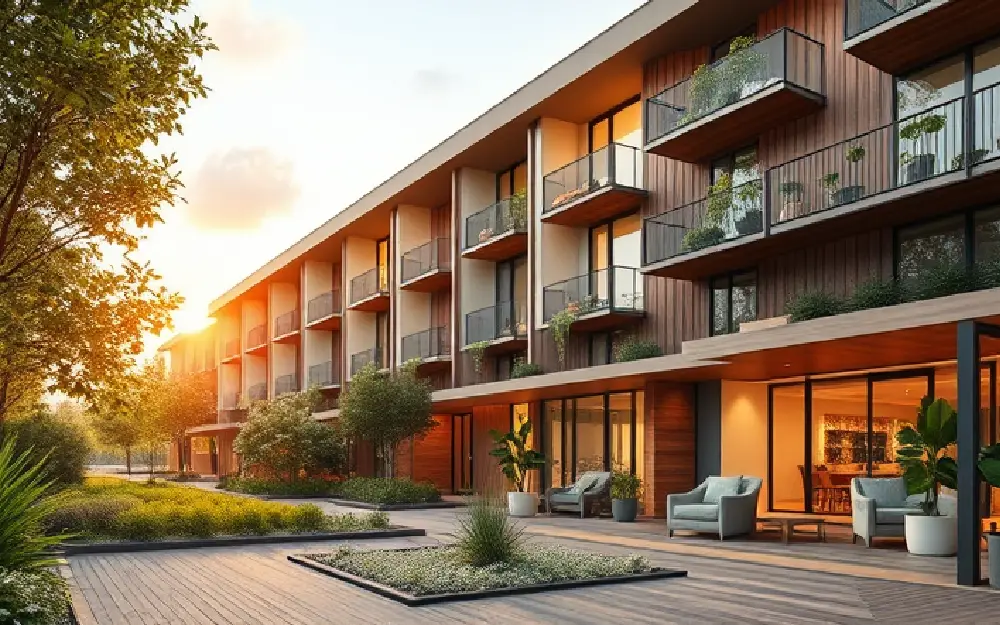
How Real Estate Developers Are Incorporating Wellness Features in Homes
In recent years, the concept of wellness has moved beyond personal health and fitness to become an essential consideration in home design. As people become more conscious of their physical and mental well-being, homebuilders and real estate developers are responding by integrating wellness features into residential properties. This shift reflects a growing demand for homes that not only provide comfort and style but also contribute to healthier lifestyles. Let’s explore how real estate developers are incorporating wellness features into modern homes.
1. Biophilic Design: Bringing the Outdoors In
One of the most prominent wellness trends in real estate development is biophilic design, which seeks to create a deeper connection between residents and nature. This can be achieved through the use of large windows that let in natural light, indoor plants, living green walls, and the incorporation of natural materials like wood, stone, and bamboo. Research shows that exposure to nature can reduce stress, improve mood, and increase cognitive function. By bringing the outdoors inside, developers are helping homeowners achieve a sense of calm and balance in their daily lives.
2. Natural Lighting for Better Health
Natural light plays a crucial role in maintaining a healthy circadian rhythm, which is vital for quality sleep and overall well-being. Developers are increasingly prioritizing daylight maximization by incorporating expansive windows, skylights, and open layouts that allow sunlight to flow freely throughout the home. Some properties are even incorporating advanced lighting systems that mimic natural daylight patterns, adjusting the intensity and color temperature of the light throughout the day to improve mood and energy levels.
3. Advanced Air and Water Filtration Systems
Clean air and water are fundamental to good health, and real estate developers are recognizing the importance of these elements in the home environment. Many new homes now come equipped with advanced air filtration systems designed to remove allergens, dust, and other pollutants, ensuring that the air quality remains optimal. In addition, developers are increasingly installing water filtration systems to eliminate contaminants, ensuring that residents have access to purified water throughout their homes.
4. Fitness Spaces and Amenities
Fitness is a key component of wellness, and developers are making it easier for homeowners to stay active without leaving the comfort of their homes. Many new residential projects feature dedicated home gyms, private yoga studios, or even outdoor fitness areas, making it convenient for residents to maintain their physical health. For those looking for more variety, some developments offer access to state-of-the-art wellness centers or communal fitness facilities, complete with pools, saunas, and personal trainers.
5. Noise Reduction for Peaceful Living
Noise pollution can be a major source of stress and sleep disruption, and developers are responding by incorporating soundproofing materials and designs that reduce noise levels. This includes using thicker walls, triple-glazed windows, and sound-absorbing flooring to create quieter, more peaceful living spaces. The goal is to foster a tranquil environment that promotes relaxation and helps residents unwind after a busy day.
6. Sustainable and Non-Toxic Materials
Wellness isn’t just about physical health—it also encompasses environmental and mental well-being. As part of the growing trend toward sustainability, real estate developers are choosing eco-friendly and non-toxic materials for their builds. This includes using low-VOC paints, sustainable hardwood flooring, and eco-conscious insulation. These materials not only contribute to a healthier living space but also have a positive impact on the environment, helping homeowners feel good about their ecological footprint.
7. Outdoor Spaces for Mental Health
Access to outdoor spaces is another key element of wellness-focused home design. Developers are increasingly integrating outdoor living areas, such as patios, gardens, and rooftop terraces, into residential designs. These spaces provide residents with the opportunity to relax, meditate, or engage in outdoor activities, contributing to improved mental health and a sense of community. In urban areas, developers are also incorporating shared green spaces that encourage social interaction and promote a healthier lifestyle.
8. Smart Home Technology for Personalized Wellness
Technology is playing an increasingly important role in wellness, and many homes now come equipped with smart home devices that monitor and enhance residents’ well-being. From air quality sensors to smart thermostats that adjust the temperature for optimal comfort, these technologies give homeowners greater control over their living environment. Some homes even include wearable health tech integrations that sync with home systems to monitor sleep patterns, heart rate, and other vital signs.
9. Mindful Design for Emotional Well-Being
Beyond physical health, many real estate developers are focusing on emotional well-being by designing spaces that foster mindfulness and a sense of peace. This can include open floor plans that reduce clutter, calming color schemes, and spaces dedicated to relaxation and reflection, such as meditation rooms or quiet nooks. These thoughtful design choices help create an environment where residents feel comfortable, calm, and emotionally centered.
The Bottom Line: A Growing Market for Wellness Homes
The demand for homes with wellness features is on the rise, and real estate developers are keen to meet this demand. By prioritizing the physical, mental, and emotional well-being of homeowners, developers are creating spaces that cater to the needs of a health-conscious, sustainability-minded market. As more people seek homes that offer not just shelter, but also a sanctuary for health and happiness, we can expect wellness features to become an even more integral part of the residential design landscape.
Incorporating wellness features into homes is more than just a trend—it’s a lifestyle shift that reflects the growing importance of holistic health. Whether it’s through better air quality, access to nature, or spaces for relaxation and fitness, developers are recognizing that a healthy home is a happy home, and they’re creating properties that enhance every aspect of a person’s well-being.
